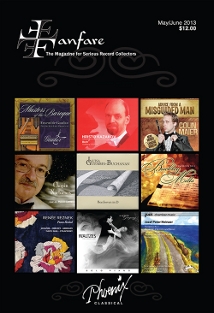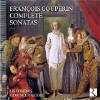Texte paru dans: / Appeared in:

Fanfare Magazine: 36:5 (05-06/2013)
Pour
s'abonner / Subscription information
Les abonnés à Fanfare Magazine ont accès aux archives du
magazine sur internet.
Subscribers to Fanfare Magazine have access to the archives of the magazine
on the net.
Ricercar
RIC330

Code-barres / Barcode : 5400439003309
Consultez toutes les évaluations recensées pour ce cd
~~~~ Reach all the evaluations located for this CD
In 1726 Couperin addressed his audience in the preface to Les Nations with a story that has since become famous. Referring to La Pucelle, he wrote: “I was much taken with the sonatas of Signor Corelli…I ventured to compose one of my own…Knowing the harshness of French attitudes towards any kind of foreign innovation, and not being absolutely certain of myself, I did myself a small service in the form of an official untruth. I claimed that my relative in the service of the King of Sardinia had sent me a sonade by a new Italian author…Under the disguise of my Italianized name, I received great acclaim. Fortunately, my sonades found sufficient favor that my equivocation does not make me blush.” (The anecdote is believed truthful. The relative Couperin refers to was likely Marc-Roger Normand, his aunt Elisabeth’s son, whose own music was long thought missing until a small number of his pieces showed up as recently as 1997 in a manuscript in an Italian private collection, along with works attributed to other composers. He did indeed serve the Duchy and later Kingdom of Sardinia at its court in Savoy, where he eventually rose from harpsichord teacher to its reigning family, to musical director in their service.)
The sonades—Couperin Gallicized sonata in part because his was an adaptation, in part out of the prickliness of many in his French audiences, to indicate that he wasn’t simply aping Italian fashions—were published much later than they were written. Unlike quite a few of his contemporaries, the composer disliked public quarrels; and there was nothing but controversy surrounding Italian musical manners for decades after it first appeared in French artistic salons. Couperin’s mix of French and Italianate forms and content wouldn’t have endeared him to critics of ultramontane music in any case, but by the time these works were published, there was a ready market for them.
Of these sonades, three were later combined with newly composed dance suites to form three-quarters of Les Nations. The other hybrid sonade suite, L’Impériale, was long considered a work newly composed for that collection, but a manuscript recently discovered in Dresden, in Johann Georg Pisendel’s handwriting, shows that it too derived from a sonade, entitled La Convalescente. This has led to Ricercar’s claim that Les Dominos’ album is more truly “complete”—a tenuous point, since it basically means they’ve included the first section of the popular L’Impériale. The true distinction of La Convalescente lies in correcting the history books.
The performances by Les Dominos are expert. The ensemble was formed in 2003, and consists of four members under violinist Florence Malgoire’s direction. Here they are expanded to eight for the only non-trio sonata in the lot, La Sultane. Their flexible, long-breathed phrasing adds much to the first movements of La Convalescente and La Sultane; their application of ornaments, natural-sounding and piquant. They don’t rush pauses: The air in La Steinquerque (a dancing air, with its ancestry in such pieces like the “Pur ti miro” section of Monteverdi’s finale to L’incoronazione di Poppea) is given all the time it needs to properly spin out its harmonic suspensions. Tempos are varied but sensible, textures transparent enough to make Couperin’s counterpoint always clear. The close, slightly dry sound helps, and also makes apparent these musicians possess uniformly attractive instrumental tone. No wiry sound cured through a large dose of anachronistic cathedral-like resonance here.
Strongly recommended, then, for music, performances, and engineering.
Cliquez l'un ou l'autre
bouton pour découvrir bien d'autres critiques de CD
Click either button for many other reviews


